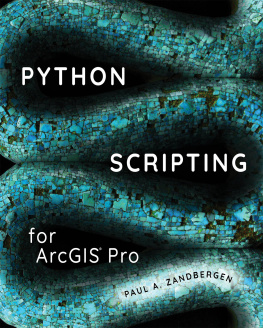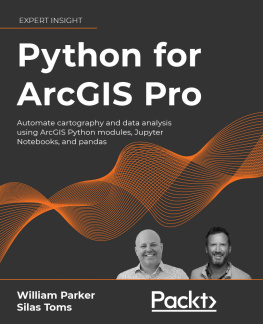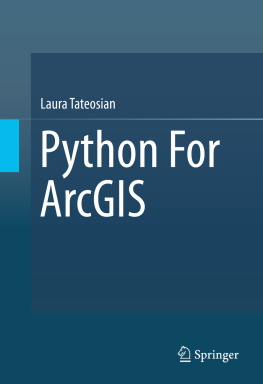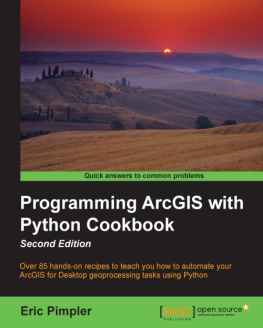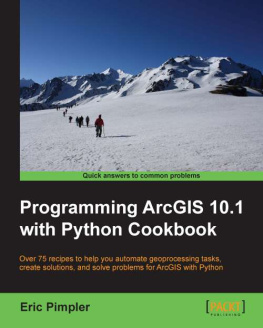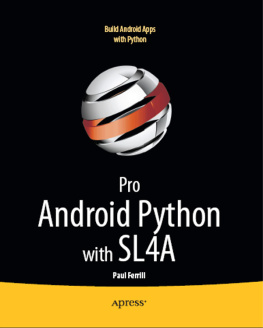Paul A. Zandbergen - Python Scripting for ArcGIS Pro
Here you can read online Paul A. Zandbergen - Python Scripting for ArcGIS Pro full text of the book (entire story) in english for free. Download pdf and epub, get meaning, cover and reviews about this ebook. year: 2020, publisher: Esri Press, genre: Computer. Description of the work, (preface) as well as reviews are available. Best literature library LitArk.com created for fans of good reading and offers a wide selection of genres:
Romance novel
Science fiction
Adventure
Detective
Science
History
Home and family
Prose
Art
Politics
Computer
Non-fiction
Religion
Business
Children
Humor
Choose a favorite category and find really read worthwhile books. Enjoy immersion in the world of imagination, feel the emotions of the characters or learn something new for yourself, make an fascinating discovery.
- Book:Python Scripting for ArcGIS Pro
- Author:
- Publisher:Esri Press
- Genre:
- Year:2020
- Rating:3 / 5
- Favourites:Add to favourites
- Your mark:
- 60
- 1
- 2
- 3
- 4
- 5
Python Scripting for ArcGIS Pro: summary, description and annotation
We offer to read an annotation, description, summary or preface (depends on what the author of the book "Python Scripting for ArcGIS Pro" wrote himself). If you haven't found the necessary information about the book — write in the comments, we will try to find it.
Python Scripting for ArcGIS Pro — read online for free the complete book (whole text) full work
Below is the text of the book, divided by pages. System saving the place of the last page read, allows you to conveniently read the book "Python Scripting for ArcGIS Pro" online for free, without having to search again every time where you left off. Put a bookmark, and you can go to the page where you finished reading at any time.
Font size:
Interval:
Bookmark:

Python Scripting for ArcGIS Pro
The definitive, easy-to-follow guide to writing Python code with spatial data in ArcGIS Pro, whether youre new to programming or not.
Python Scripting for ArcGIS Pro starts with the fundamentals of Python programming, and then dives into how to write useful Python scripts that work with spatial data in ArcGIS Pro. Learn how to execute geoprocessing tools and describe, create, and update data, as well as execute a number of specialized tasks. See how to write simple custom scripts that will automate your ArcGIS Pro workflows.
Some of the key topics you will learn include:
- Python fundamentals
- Setting up a Python editor
- Automating geoprocessing tasks using ArcPy
- Exploring and manipulating spatial and tabular data
- Working with geometries using cursors
- Working with rasters and map algebra
- Map scripting
- Debugging and error handling
Helpful points to remember, key terms, and review questions are included at the end of each chapter to reinforce your understanding of Python. Corresponding data and exercises are available online.
Whether you want to learn Python or already have some experience, Python Scripting for ArcGIS Pro is the comprehensive, hands-on book for learning the versatility of Python coding as an approach to solving problems and increasing your productivity in ArcGIS Pro. Follow the step-by-step instructions and common workflow guidance for automating tasks and scripting with Python.
Dont forget to also check out Esri Presss other Python title: Advanced Python Scripting for ArcGIS Pro.
Dr. Paul A. Zandbergen is a professor in the GIS program at Vancouver Island University. His teaching includes courses in introductory GIS, spatial analysis and modeling, spatial statistics, and GIS programming. His research focuses on the robustness of spatial analytical techniques in the areas of crime analysis, environmental science, public health, spatial ecology, and water resources. His research has been funded by the National Science Foundation, the National Institute of Justice, and the National Institutes of Health. He has published over 50 journal articles and book chapters. Zandbergen is the author of Python Scripting for ArcGIS, published in 2013 by Esri Press. He lives with his family in Vancouver, British Columbia, Canada.
Published by Esri Press.

A book of this scope materializes only with the support of many individuals.
First, I would like to recognize the numerous students in my courses over the years at several institutions. You learn something best by teaching it to others, and Im fortunate to have worked with many aspiring GIS professionals interested in learning Python. Much of what I know about what needs to go in a book like this, I have learned from them.
The contributions of the staff at Esri Press cannot be underestimated. Their ongoing feedback throughout the writing and editing of the manuscript has been invaluable. Other Esri staff members also have left their mark on the book, especially David Wynne, Jeff Barrette, and Nawajish Noman. Their insider perspectives have made the book more accurate and more complete.
Since the publication of the first book, Python Scripting for ArcGIS, I have received a lot of feedback from numerous students, instructors, GIS professionals, and anonymous reviewers. Ive done my best to incorporate all that Ive learned from them into this new book.
I also would like to thank my parents, who always encouraged me to seek a career path that would allow me to fulfill my curiosity about the world while at the same time trying to make it a better place.
Most importantly, this book would not be possible without the continued support of my family. Marcia, Daniel, and Sofia, thank you for believing in me and allowing me to pursue my passions.
Paul A. Zandbergen
Vancouver, BC, Canada
For those new to Python scripting, welcome to a whole new world! Programming has become an increasingly important aspect of the skillset of GIS professionals in many fields. Most GIS jobs require at least some experience in programming, and Python is often at the top of the list. If you are looking to kickstart your GIS programming skills, this book is for you.
Python scripting allows you to automate tasks in ArcGIS Pro that would be cumbersome using the regular menu-driven interface. For example, consider having to convert 1,000 shapefiles into feature classes in a geodatabase. You could run the appropriate tool 1,000 times to complete the task, but surely there must be a more efficient and robust way to do it. Thats where Python scripting comes in, and you need only a handful of lines of code to carry out this task. About halfway through the book, you will write a script that does exactly that.
Before getting further into the contents of this book, a bit of history is in order. In 2013, Esri Press published Python Scripting for ArcGIS. I wrote the book to serve as an easy-to-understand introduction to Python in order to create scripts for ArcGIS Desktop. At the time, ArcGIS Desktop was version 10.1 and used Python version 2. The book quickly became popular among students and professionals, but several years later the book was no longer up to date.
ArcGIS Pro was released in 2015 and further established Python as the preferred scripting language within the ArcGIS platform. ArcGIS Pro uses Python version 3, which is significantly different from version 2. As the industry started to shift from ArcGIS Desktop 10.x to ArcGIS Pro, interest grew in an updated version of the book. Both the changes in ArcGIS and the differences in Python versions necessitated a completely new booknot just a second edition of the existing book with minor code updates.
The current book is written for ArcGIS Pro 2.5, which uses Python 3.6.9. Most of the code will work in earlier versions of ArcGIS Pro, except for the most recently added functionality. As new functionality is added to future releases of ArcGIS Pro, the code in this book will continue to work. However, much of the code will not work in ArcGIS Desktop 10.x.
This book is designed to make the power of Python scripting available to those who have limited experience writing code. The book starts with the basics, such as what scripting is and how to write and run simple lines of code. Following this, the book covers how to write scripts that work with spatial data in ArcGIS Pro. A good familiarity with ArcGIS Pro is assumed, including managing data, creating cartographic output, and running tools. You should also be familiar with the basic concepts of GIS, including coordinate systems, data formats, table operations, and basic spatial analysis methods. If you have some experience in writing code in any programming language, it will be helpful but is not required.
Why Python? For a couple of reasons. First, Python is free and open source, meaning it can be freely distributed and shared. Second, it is a powerful and versatile programming language although still relatively easy to learn. Third, Python is the preferred language for working with ArcGIS Pro, which is strongly reflected in the functionality of the software.
Although Python is part of the installation of ArcGIS Pro, it is important to remember that Python was not developed by Esri. A large and active Python community maintains and continues to improve Python. As you learn the fundamentals of Python in this book, the additional benefit is that you may find other uses for Python beyond working with ArcGIS Pro. Many introductory computer science courses use Python to explain fundamental concepts in computer programming. This book introduces you to some of these fundamentals, but the emphasis is on writing code specifically designed to work with spatial data in ArcGIS Pro.
Font size:
Interval:
Bookmark:
Similar books «Python Scripting for ArcGIS Pro»
Look at similar books to Python Scripting for ArcGIS Pro. We have selected literature similar in name and meaning in the hope of providing readers with more options to find new, interesting, not yet read works.
Discussion, reviews of the book Python Scripting for ArcGIS Pro and just readers' own opinions. Leave your comments, write what you think about the work, its meaning or the main characters. Specify what exactly you liked and what you didn't like, and why you think so.

